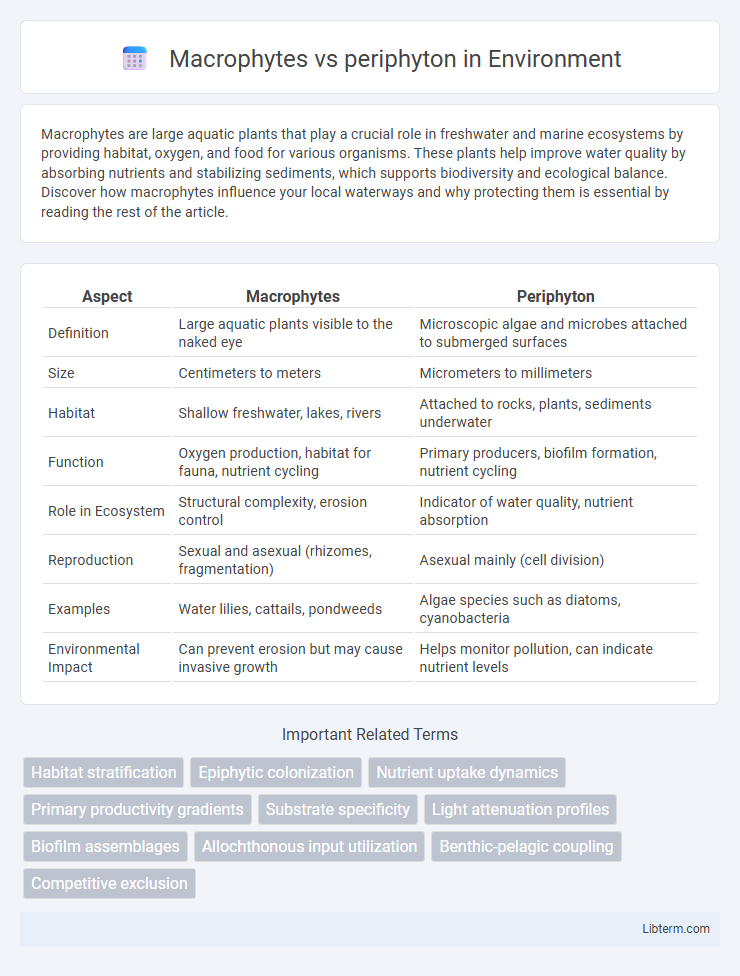Macrophytes are large aquatic plants that play a crucial role in freshwater and marine ecosystems by providing habitat, oxygen, and food for various organisms. These plants help improve water quality by absorbing nutrients and stabilizing sediments, which supports biodiversity and ecological balance. Discover how macrophytes influence your local waterways and why protecting them is essential by reading the rest of the article.
Table of Comparison
| Aspect | Macrophytes | Periphyton |
|---|---|---|
| Definition | Large aquatic plants visible to the naked eye | Microscopic algae and microbes attached to submerged surfaces |
| Size | Centimeters to meters | Micrometers to millimeters |
| Habitat | Shallow freshwater, lakes, rivers | Attached to rocks, plants, sediments underwater |
| Function | Oxygen production, habitat for fauna, nutrient cycling | Primary producers, biofilm formation, nutrient cycling |
| Role in Ecosystem | Structural complexity, erosion control | Indicator of water quality, nutrient absorption |
| Reproduction | Sexual and asexual (rhizomes, fragmentation) | Asexual mainly (cell division) |
| Examples | Water lilies, cattails, pondweeds | Algae species such as diatoms, cyanobacteria |
| Environmental Impact | Can prevent erosion but may cause invasive growth | Helps monitor pollution, can indicate nutrient levels |
Introduction to Macrophytes and Periphyton
Macrophytes are large aquatic plants visible to the naked eye, commonly found in freshwater and marine environments, contributing significantly to ecosystem structure and nutrient cycling. Periphyton consists of complex assemblages of microorganisms, including algae, bacteria, and fungi, attached to submerged surfaces, playing a crucial role in primary production and water quality. Both macrophytes and periphyton serve as essential components of aquatic habitats, supporting biodiversity and influencing biogeochemical processes.
Defining Macrophytes: Structure and Function
Macrophytes are large aquatic plants visible to the naked eye, typically rooted in sediment with complex structures including stems, leaves, and roots that enable nutrient uptake and oxygen production. They play a critical role in aquatic ecosystems by providing habitat, stabilizing sediments, and influencing water chemistry through photosynthesis and respiration. Unlike periphyton, which consists of microscopic algae and microbes attached to surfaces, macrophytes contribute significantly to primary production and nutrient cycling in freshwater and marine environments.
Understanding Periphyton: Composition and Characteristics
Periphyton is a complex assemblage of algae, bacteria, fungi, and detritus attached to submerged surfaces in aquatic environments, characterized by its biofilm structure. Unlike macrophytes, which are larger aquatic plants rooted in sediments, periphyton forms thin, sticky layers that serve as a crucial food source and habitat for various microorganisms and invertebrates. Its composition varies with water chemistry, light availability, and substrate type, influencing nutrient cycling and ecosystem productivity in freshwater systems.
Key Differences Between Macrophytes and Periphyton
Macrophytes are large, multicellular aquatic plants such as water lilies and cattails, whereas periphyton consists of complex communities of algae, bacteria, and detritus attached to submerged surfaces. Macrophytes contribute significantly to oxygen production and habitat structure in freshwater ecosystems, while periphyton plays a crucial role in nutrient cycling and serves as a primary food source for many aquatic organisms. Unlike periphyton, which is microscopic and forms biofilms, macrophytes are visible plant structures with roots, stems, and leaves.
Ecological Roles in Aquatic Ecosystems
Macrophytes provide essential habitat structure, stabilize sediments, and contribute to oxygen production through photosynthesis in aquatic ecosystems. Periphyton, complex communities of algae and microbes attached to submerged surfaces, play a crucial role in nutrient cycling by breaking down organic matter and supporting primary production. Both macrophytes and periphyton enhance biodiversity and water quality, but macrophytes have a larger impact on physical habitat modification while periphyton primarily influences microbial food webs.
Contributions to Primary Productivity
Macrophytes contribute significantly to primary productivity by providing large biomass through photosynthesis in freshwater and marine ecosystems, serving as essential habitats for aquatic organisms. Periphyton, a complex assemblage of algae, cyanobacteria, and microbes attached to submerged surfaces, plays a crucial role in nutrient cycling and supports primary production especially in nutrient-rich and light-variable environments. Both macrophytes and periphyton enhance ecosystem productivity but differ in growth form and ecological niche, with macrophytes dominating as larger, rooted plants and periphyton as microscopic biofilms.
Influence on Water Quality and Nutrient Cycling
Macrophytes play a crucial role in enhancing water quality by stabilizing sediments, absorbing nutrients such as nitrogen and phosphorus, and providing habitat for aquatic organisms, which collectively reduce eutrophication. Periphyton, a complex assemblage of algae, bacteria, and microbes attached to submerged surfaces, contributes to nutrient cycling by rapidly assimilating dissolved nutrients and facilitating organic matter decomposition, thereby influencing oxygen dynamics and nutrient availability. Both macrophytes and periphyton serve as key biological components in freshwater ecosystems, effectively regulating nutrient fluxes and maintaining ecological balance.
Interactions and Competition in Aquatic Habitats
Macrophytes and periphyton interact dynamically in aquatic habitats by competing for light, nutrients, and space, which significantly influences ecosystem productivity and biodiversity. Macrophytes provide substrate and habitat structures that facilitate periphyton colonization, while dense periphyton growth can limit macrophyte photosynthesis by shading leaves. These competitive interactions vary with water nutrient levels, flow conditions, and grazing pressure, shaping community composition and nutrient cycling within freshwater environments.
Environmental Factors Affecting Growth
Macrophytes and periphyton growth are influenced by water temperature, light availability, and nutrient concentrations, with macrophytes requiring stable substrates and higher light for photosynthesis while periphyton thrives on submerged surfaces with variable nutrient levels. Water flow rate impacts periphyton by affecting attachment and nutrient delivery, whereas macrophytes are more affected by sediment characteristics and water depth. Both groups respond to changes in pH and dissolved oxygen, which regulate metabolic processes and community structure in aquatic ecosystems.
Implications for Aquatic Ecosystem Management
Macrophytes provide essential habitat structure and oxygenation in aquatic ecosystems, supporting biodiversity and stabilizing sediment, while periphyton serves as a primary food source and bioindicator of water quality. Effective aquatic ecosystem management requires balancing macrophyte proliferation to prevent excessive shading of periphyton mats, which can disrupt nutrient cycling and food web dynamics. Monitoring the relative abundance of macrophytes and periphyton informs nutrient management strategies and helps mitigate eutrophication impacts.
Macrophytes Infographic

 libterm.com
libterm.com